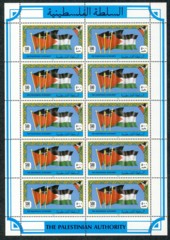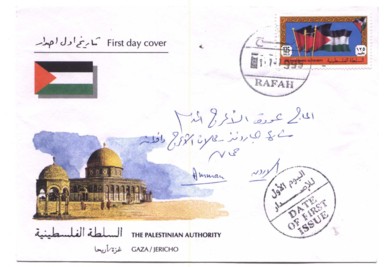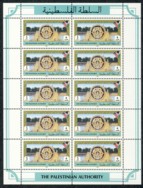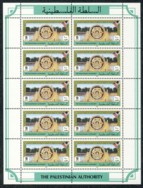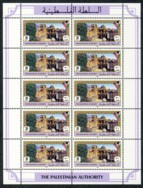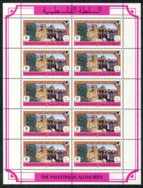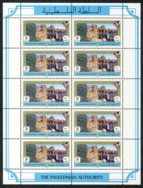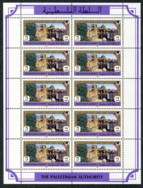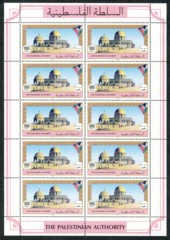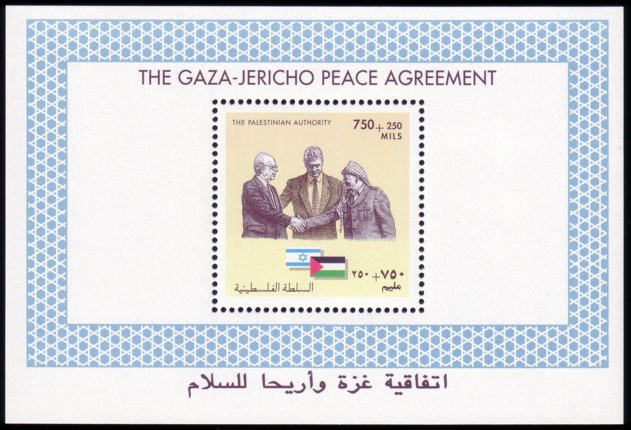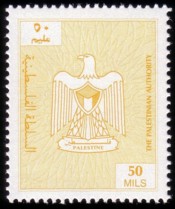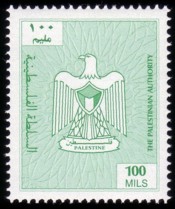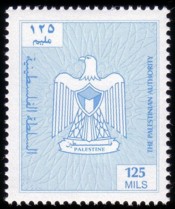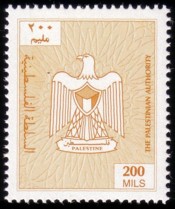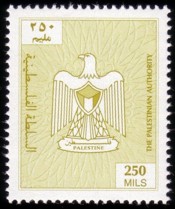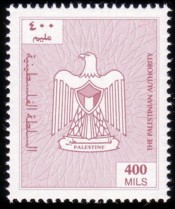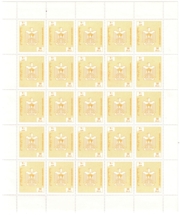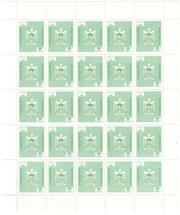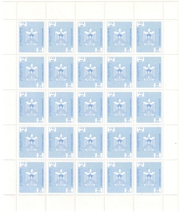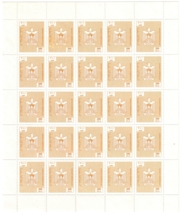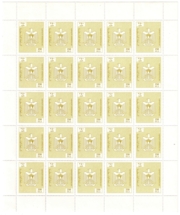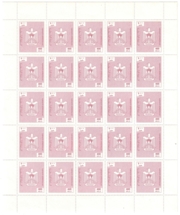|
|
During 1994, three stamp series and one block were issued:
• National Flag (15.08.1994)
• Official Stamps (15.08.1994)
• Historic Sites & Monuments (1.09.1994)
• Gaza-Jericho Peace Agreement (7.10.1994)
The denomination shown is "Mils", the name of the currency of the British Mandate over Palestine from 1927 to 1948, to the use of which Israel objected. The PNA Post reacted by using "postage paid" (ie. postage in specie) labels and handstamps for a short period.
The so-called "Jericho Local Overprints" were never officially issued or sanctioned.
|
|
|
|
Be notified of
page updates
|
|
I provide a listing of all changes to my pages. It also provides a free notification service by e-mail:
|
|
Log of Changes
|
|
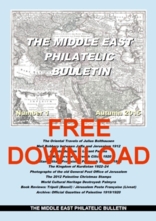
|
|
|
Georg Roll and the Launch of the PNA stamps in Autumn 1994
|
|
Due to an agreement facilitated by the PLO's representative in Germany, Abdallah al-Frangi and German politician and renowned philatelist Hans-Jürgen Wischnewski, state-owned Bundesdruckerei GmbH (Berlin) designed and printed the first stamps for the Palestinian National Authority, coodinated by philatelic agency Georg Roll Nachf. GmbH
Originally founded in 1956 by Georg Roll, the philatelic agency became Germany's largest international stamp wholesaler and distributor, also acting as agent for upto 50 countries. In 1971 it was led by Jürgen Schneider and in 1998 by state-owned Bundesdruckerei GmbH, trading as Georg Roll Nachf. GmbH.
In a management buy-out, Jürgen Schneider and his son Tomke Schneider gained control in 2001, the company was then trading as Georg Roll Briefmarken GmbH. On 1.12.2009 the company went into liquidation and was wound up as bankrupt.
The changing business and unfavourable terms of credit as well as increasing demands for advance payments lead to liquidity problems, sources also cite mis-management and too high staffing levels; 28 staff were made redundant during 2009.
The remaining business contacts and client base was taken over by Philagentur GmbH, Oberusel. Tomke Schneider, the last director, went on to become director of Swiss company Philart S.A. (his father Jürgen Schneider was director there until 2005) which went into liquidation in 2011.
External Links:
• Unrühmliches Ende einer Traditionsfirma by Thomas Vosskuhl (Kreiszeitung Wesernmarsch, 15.12.2009) 
• What happened to one of the biggest dealers in Germany? (World Stamp News, 7.06.2010)
• Es gibt einen potenziellen Investor by Hans-Carl Bokelmann (Nordwest Zeitung, NWZ Online, 17.09.2009) 
• Nur noch acht von 29 Stellen sind übrig by Hans-Carl Bokelmann (Nordwest Zeitung, NWZ Online, 12.12.2009) 
• Roll Briefmarken bedrängt by BON (Nordwest Zeitung, NWZ Online, 12.12.2009) 
• Companies' register (Handelsregister, Amtsgericht Oldenburg, HRB 100236: Georg Roll Briefmarken GmbH) 
• Philagentur website
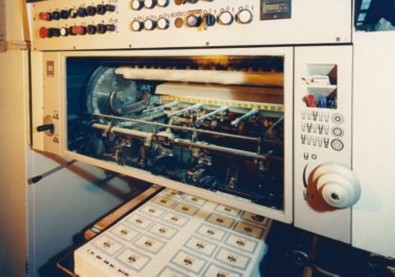
|
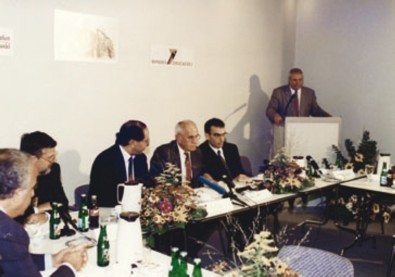
|
|
The first block (Zobbel Bl. 1) is printed at the Bundesdruckerei Berlin, 1994.
|
Press conference during "Philatelia" in Cologne, 1994: (left to right) unknown, Hans Zerbel (philatelic expert, Bundesdruckerei GmbH), Abdallah al-Frangi (head of the PLO mission/embassy to Germany), Dr. A. Ashhab (Minister of Post & Telecom, Palestine), translator (?), Jürgen Schneider (director of Palestine's official philatelic agency, Georg Roll Nachf. GmbH).
|
Source: WM-Bildarchiv, BA000882.jpg,
Foto: Bundesdruckerei Berlin, 7.10.1994
|
Source: WM-Bildarchiv, BA000886.jpg,
Foto: Wilhelm van Loo
|
|
|
Postkrieg 1994/1995
|
|
All stamps in "Mils" could only be used for internal mail within the liberated areas of Palestine. Foreign mail was allowed from 7 or 8.11.1995 only. Israel judged these stamps as invalid and returned such franked letters.
In order that mail be allowed through Israel, Palestinian postmasters then affixed small labels stating "Palestinian Authority / Postage Paid". Some senders used for this period Israeli stamps, which were still sold by Palestinian post offices.
Israel not only objected to the used of currency inscribed as "Mils", but also to the name "Palestine" that appears in the design on the "Mandate Stamps" series of 1995.
|
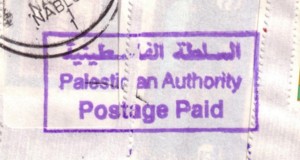
|
|
External Links:
• Dieter Becker's website: Postkrieg  (dead link) (dead link)
• Postkrieg (German Wikipedia)  . .
Original relevant texts of "Agreement on the Gaza Strip and the Jericho Area" (Cairo, 4.05.1994)
and (protocols to) "Interim Agreement on the West Bank and the Gaza Strip" (Washington, 28.09.1995):
|
|
|
26. Postal Services:
This sphere includes, inter alia, the management of post offices and postal delivery in the Gaza Strip and the Jericho Area.
The Palestinian Authority may issue postage stamps, postal stationery (hereinafter "stamps") and date stamps, subject to the following provisions:
- Stamps shall include only the term "the Palestinian Authority", the face value and the subject.
- The face value shall be stated only in the agreed legal currency circulating in the Gaza Strip and the Jericho Area as detailed in Annex IV.
- The design, symbols and subjects of stamps, postal stationery and date stamps issued by the Palestinian Authority will be in accordance with the principles outlined in Article XII of the Agreement.
- The date stamp shall include only the name of the office responsible for the cancelling of the stamp and the date of that operation.
- Both sides will coordinate and cooperate in establishing postal rates for international postal services in such a way as to prevent mutual economic harm to each other.
- The modalities and arrangements for sending and receiving all postal items, including parcels, between the Gaza Strip and the Jericho Area and Israel and the West Bank will be arranged by means of a commercial agreement between the Israel Postal Authority and the Civil Administration respectively on one side, and the Palestinian Authority on the other.
- The modalities and arrangements for sending and receiving all postal items, including parcels, between the Gaza Strip and the Jericho Area and other countries will be arranged by means of a commercial agreement between the Israel Postal Authority and the Palestinian Authority, further modalities will be discussed in the CAC.
- The customs principles detailed in Annex IV shall also apply to postal items, including parcels, transmitted to the Gaza Strip and the Jericho Area.
Source: Annex II, article 26, of
"Agreement on the Gaza Strip and the Jericho Area".
Note: Article XII mentioned above states in paragraph 1: "Israel and the Palestinian Authority shall seek to foster mutual understanding and tolerance and shall accordingly abstain from incitement, including hostile propaganda, against each other [...]"
Source: "Agreement on the Gaza Strip and the Jericho Area".
|
|
|
|
|
ARTICLE 29 Postal Services
- This sphere includes, inter alia, the planning, formulation and implementation of policies, as well as the management and supervision of post offices, postal services and all monetary transactions and activities in postal units (publicly known as "the Postal Bank").
- The Palestinian side shall issue postage stamps and postal stationery (hereinafter "stamps"), date stamps and all other related materials, subject to the following provisions:
- Stamps shall include only the terms "the Palestinian Council" or "the Palestinian Authority", the face value and the subject. Should date stamps include the name of the issuing authority, only the abovementioned terms may be used.
- The face value shall be stated only in one of the agreed legal currencies circulating in the West Bank and the Gaza Strip as detailed in Annex V (Protocol on Economic Relations).
- The design, symbols, wording and subjects of stamps and date stamps issued by the Palestinian side will be in the spirit of the peace.
- In setting postal rates for international postal services, both sides shall coordinate in such a way as to prevent mutual economic harm.
- Both sides shall ensure the efficient transmission and delivery of postal items, including parcels, destined for or originating from the other side. Similarly, they shall ensure the efficient transmission and delivery of such postal items arriving from, or destined for, foreign countries.
- The modalities and arrangements for sending and receiving all postal items, including parcels, between the two sides will be arranged by means of a commercial agreement between the Israel Postal Authority and the Palestinian side.
- The modalities and arrangements for sending and receiving postal items, including parcels, between the Palestinian side and foreign countries, will be arranged by means of commercial agreements between the PLO, for the benefit of the Palestinian side, and the Postal Authorities of Jordan and Egypt, and a commercial agreement between the Palestinian side and the Israel Postal Authority.
- Without derogating from the generality of paragraph 5 of Article IX of this Agreement (Foreign Relations), the status of the Palestinian side to this Agreement in the Universal Postal Union will remain as it is at present, and the Palestinian side will not be party to any action to alter or change its status.
- The relevant customs principles detailed in Annex V (Protocol on Economic Relations) shall also apply to postal items, including parcels transmitted to the West Bank and the Gaza Strip.
Source: Annex III, appendix 1, article 29 of
"Interim Agreement on the West Bank and the Gaza Strip".
Note: Annex V mentioned above only states in article IV that the PNA and its institutions (ie. the Post) has to accept NIS for transactions, NIS being "one of the circulating currencies".
|
|
|
|
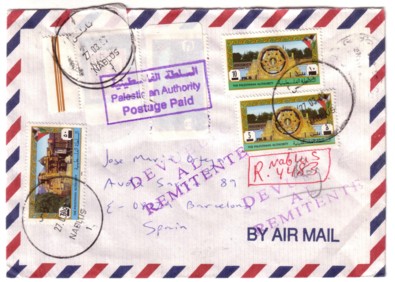
|
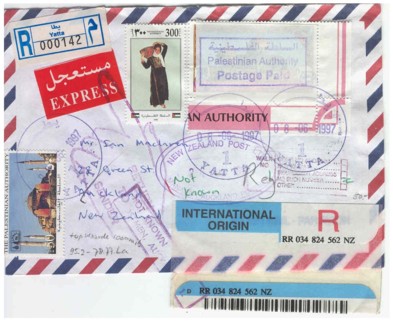
|
|
Registered letter from Nablus to Spain, returned. Five stamps for a total of 470 Fils: 3 "Views" overprinted (Zobbel nos. 21, 22, 24 at 5, 10, and 30f, one original "View" (Zobbel no. 12, 75m) and "Mandate stamps" (Zobbel no. 31, 350f), covered with blank label and cachet "Palestinian Authority / Postage Paid". Postmark: Nablus 1, 27.03.1996 (no. 78, type IIc); on reverse "Certificado" mark of Barcelona, 19.04.1996. Manual registration mark Nablus 4483 (type X).
|
Same handwiting on this registered express letter: from Yatta 8.06.1997 (no. 108, type IIIa) to New Zealand, then returned. Registration label Yatta 000142 (type B2).
Image courtesy Dieter Becker.
|
|
|
|
The "Jericho Local Overprints"
|
|
The Postmaster of Jericho, according to reports, produced an unauthorized local overprint: with a small rubber handstamp (provided by the Ministry) he obliterated "Mils" with "Fils". These overpints are known in (greenish) black, red and (blueish) purple.
Reports and covers seen suggest they were apparently accepted by Israel and tolerated by the Palestinian postal authorities at the time. However, as this action was never authorized by the Minstry these are not official stamps. As a curiosity though they may be worth collecting—preferrably on cover! (see below)
|
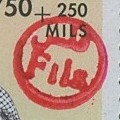
|
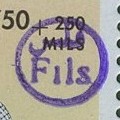
|
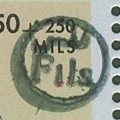
|
|
|
Dubious Palestine overprints : making a fast buck with a handstamp
On first sight one may have overlooked. On second sight one is surprised. But with another look one should become suspicious. I'm referring to the handstamped provisionals on 1994 Palestinian stamps which are "unauthorized manipulations of official stamps" according to a statement from the Palestinian Ministry of Post.
The attention was great when the Palestinian Authority presented its own stamps in the Fall of 1994 to an amazed public. However, the first issues for the autonomous territories of Gaza and Jericho have one flaw: they bear the old Palestine-denomination "Mils". Israel protested successfully to the Universal Postal Union. Palestinian stamps denominated in Mils could therefore only be used within in the autonomous territories.
In order to facilitate the participation in international postal exchanges, all stamps issued in 1994 with "Fils" – the Jordanian currency recognized by Israel – were machine-overprinted [meaning newly printed Fils designs resembling overprints, Zobbel nos. 16–29] in the spring of 1995 at the Bundesdruckerei. But apparently it took until 8th November 1995 that the Palestinian stamps were officially accepted for mail outside the autonomous areas.
In January 1996, the editors of the Deutsche Briefmarken-Revue received some letters sents from Gaza and Jericho whose stamps all showed some special feature: the denomination [value and currency] are overprinted with a round handstamp "Fils" in Arabic and English.
A closer look shows that part of the handstamp passes over onto on the envelope, ie. the impression obviously only occured when the stamps were already already stuck onto the envelope. One gets more suspicious by the usage of overprinted official stamps on private letters.
Jürgen Schneider, whose agency Georg Roll is responsible for the worldwide distribution of Palestinian stamps, immediately clarified the facts and confirmed "that there was at no time an official overprint of Palestinian stamps. Therefore these must be private fakes."
Minister of Post Dr. Ashab added in a statement: "The overprinted stamps (meaning those manufactured in Berlin – author's note) [ie. the new Fils designs resembling overprints, Zobbel nos. 16–29] have been available on time and in sufficient quantities at all post offices, so that at no time there was any need to have ordered a handstamping action."
According to our research, all Palestinain stamps denominated in Mils exist with the dubious handstamp overprints. These are the definitive series "National Flag" (Mi 1/5), the sefinitive series "Sights" (Mi 6/13), the block "Signing of the Gaza-Jericho Agreement" (Mi 14 and Block 1) and the official stamps "National Arms" (Mi 1/6), which [referring to the latter] were not at all overprinted [meaning reprinted with an altered design] in Berlin.
The covers known to us were sent from Jericho, the Gaza Strip and Israel (some even as registered) and were transported without objection, as proven by directional and arrival potmarks. But also loose mint stamps with handstamp overprints have surfaced.
For Dr. Ashab it is clear "that individual opponents of our state – knowledgable in the field of philately – try to inflict damage to this young area of collection. This can be seen just alone by the fact that the handstamps have surfaced in several colors." Because they are officially counterfeit, [forgeries] to the detriment of philately, the question about their worthiness to be collected is answered. Every penny spent for these handstamp overprints is a penny too much!
Source: Jan Billion: Dubiose Palästina-Aufdrucke : mit dem Handstempel die schnelle Mark machen. In: Deutsche Briefmarken-Revue. Vol. 47, 1996, no. 6, p65.
(translated from the German, PDF of original article)
|
|
|
|
|
The postmaster at Jericho was provided with a small rubber stamp by the postal authority of the PNA to be used as an emergency overprint should the FILS overprints not arrive from Germany in time.
This small stamp had the word Fils (in Arabic and English) inside a circle of external diameter 7.5mm. As a favor to collector, and without having received an order from his superiors to proceed, the postmaster of Jericho decided to act on his own and hand overprinted the mils designation in the offending mils issues using several different colored inks: red, black and purple.
These marks were applied to the Flags and Monuments issues, the Eagle ("official") issue and the Peace Agreement ouvenir sheet. There are also errors of stamping, such as misplacements and extra strikes. So this issue was not an outright forgery, but an unauthorized use of the emergency overprint.
Despite the fact that these actions were not approved by the authorities and were strictly a private overprint, stock of these stamps spread throughout the West Bank and the Gaza Strip.
Post offices and postal clerks all over the Palestinian territories appear to have had no reservations about using these unauthorized overprints. The earliest dates we have seen applied (all using legal postmarks) are 9.7.95 in Jericho and 10.7.95 in the Gaza Strip.
Source: Paul J. Phillips and Josef Wallach: The birth of a new postal system :
the Palestinian National Authority ; 1994–2008.
In: American Philatelic Congress Book. No. 75, 2009, p101–p103.
|
|
|
|
|
The rubber stamped "Jericho Locals" stamps Chap. 5h
Changing the currency of stamps, using a rubber stamp
Due to the promise of Israel P. M. [the Israeli prime minister] to approve the stamps after change of the currency by an overprint i.e. Fils instead of Mils, the Pal. Auth ordered in Germany a reprint of the early issues of stamps, with an overprint of "FILS" currency. These series of stamps appeared on 10.Apr.1995.
As a safety measure, in case the revised stamps will not appear in time, the P.A. prepared a small rubber cachet bearing the word "Fils:". The intention was to apply this cachet manually on existing stock of Mils stamps. Eventually the stamps appeared in time, and NO need was to use this handstamp.
However the postmaster of Jericho applied the Fils cachet on some of the Mils issues as a gesture [to the author, ie. Mr. Wallach]. They are tilled [?] or named "The Jericho Locals". Some of them were posted at Jericho and Gaza Strip post offices. They appear in three colors: violet, red, and black. They were accepted for postage at all P.A. offices and went through Israel (for overseas) without objection.
Source: J. Wallach: "The establishment of the Palestinian Authority Post. Chapter 5: The Palestine Authority Stamps" and (with slightly different text): "The establishment of the Palestinian Authority Post. Chapter 5: The Palestine Authority Stamps"
(both accessed 5.02.2014).
Note: orthography and punctuation has been corrected as the text had been originally translated from Hebrew to English rather poorly; I have added a few comments (in square brackets) for better understanding.
|
|
|
|
Images of the overprint details and Block 1: Rolf Wernecke.
|
|
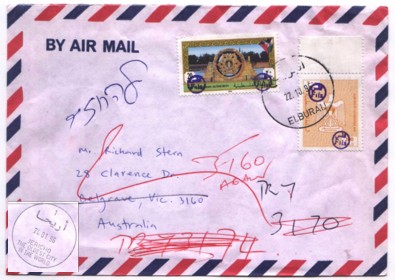
|
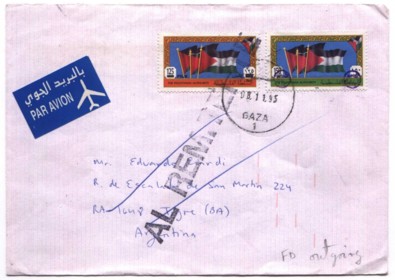
|
Letter from Burage (Gaza-Strip) to Australia. Failed to reach addressee at various postcodes.
Postmark: ELBURAIJ / 22.10.95 (type SZ IId). On reverse: Jericho arrival postmark 24.01.1996 (insert).
Likely of philatelic origin: 20m historic sites paired with 200m official (!) stamp, used far away from Jericho, at a time when regular stamps in Fils were already available.
|
Another returned letter, this time from Gaza to Argentina.
Postmark: GAZA / 1 / 08.11.95 (type SZ IIb).
Again of philatelic origin: note the identical handwriting! Here the sender paired two stamps from the flag series: a 125f regular stamp (10.04.1995) with a 150m stamp (15.08.1994) bearing the Jericho handstamp.
|
|
Images of both covers courtesy of Thomas Schubert.
|
|
National Flag 1994
The stamps, depicting the national flag of Palestine were printed in three different sizes at Bundesdruckerei Berlin in sheets of 10 (2x5) and have denominations of 125, 150, 250, 300, and 500 Mils (total: 1,325 Mils). Print run: unknown. Perforation: K 14. Designer: Bernd Görs.
There were two official FDCs issued, bearing the special postmark dated 1.08.1994: the first FDC contains stamps Zobbel nos. 1–4, the second stamp Zobbel no. 5.
External links:
• Görs designed several stamps for Berlin and Germany in the 1980s and 1990s: Bernd Görs (Wikimedia Commons)
| Zobbel | Value | Size | Perfor. | Printed | Notes |
| 1 | 125m | 43.75x26.25mm | K 14 | n/a | sheets of 10 (2x5) |
| 2 | 150m |
| 3 | 250m | 46x27.32mm |
| 4 | 300m |
| 5 | 500m | 55x32.8mm |
|
|
|
|
|
|
|









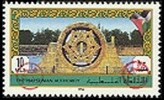
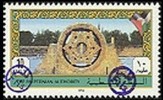
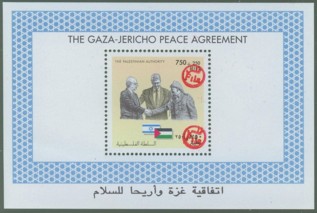







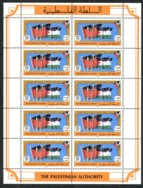
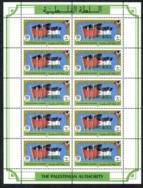 >
>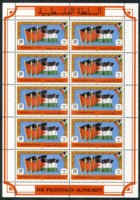 >
>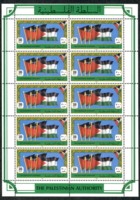 >
>